Far Cry 4 Review
It’s hard to believe that the Far Cry series started ten years ago with a tropical island and a story about mutants. As a series, it’s travelled a long way since then, from the more serious overtones of FC2’s desert, to an archipelago populated by lunatics for FC3, with its darker, but racially controversial, plot.
As a result, the weight of history sits on Far Cry 4. Its predecessor’s commercial success means Ubisoft daren’t meddle too deeply with a formula proven to work, all the while avoiding the “white savior” message inadvertently delivered by the unlucky tourist of Far Cry 3.
The answer comes in the form of Ajay Ghale, returning to his homeland of Kyrat to scatter his mother’s ashes. It’s a solemn introduction, so when your bus is hijacked by the unhinged King Pagan Min, you instantly care more than you did about some idiot tourists getting kidnapped in a place they knew they shouldn’t be. You’re sprung from Min’s grasp by a group of freedom fighters called The Golden Path, and from then on you’re free to explore mountainous Kyrat.
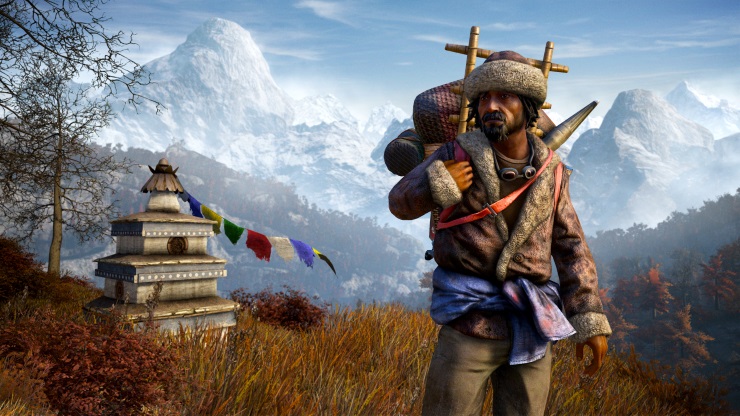
Naturally you fall in with the rebels, who seem to know of Ajay’s father Mohan Ghale. There will be no spoilers here, but it is safe to say that the plot makes much more sense than last time around, with Ajay working his way to the top of the resistance, sitting just below its leaders Amita and Sabal. Ubisoft seem to have learnt their lesson: Ajay is helping to liberate his home country; he’s not a foreigner coming in and placing his stamp on proceedings, even if the American voice acting would suggest otherwise.
What he does do, though, is pick sides. Throughout the campaign you are given the option of answering either Sabal or Amita’s requests for aid. Both make convincing arguments, and choosing between them is incredibly difficult. Even harder are the consequences: the leader you rejected will confront you once you’ve completed the mission, explaining their motivations in greater detail, making you see what they were trying to achieve. I have never felt more guilty in a video game.
The characterisation is sublime. Sabal is concerned with preservation, both of life and tradition, while Amita wants to build a better, brighter and crucially more equal Kyrat, hence the personality clashes. Pagan Min meanwhile is the perfect villain, frighteningly calm yet utterly mad, a cross between the terrifying insanity of Vaas and the joyful menace of Borderlands 2’s Handsome Jack, right down to the cheery phone calls.
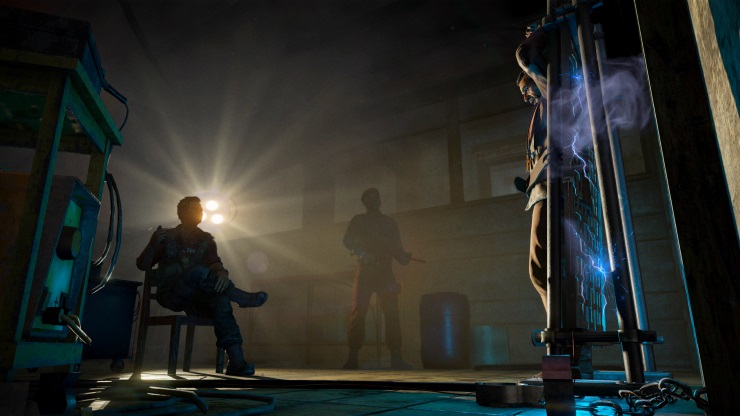
This extends to the wider cast: Pagan’s lieutenants all have their own personalities, while the ex-Warlord turned Priest, Longinus, preaches to you while handing you an AK-47. Best of all are Yogi and Reggie, drug addicts you meet halfway through the story that I shan’t spoil for you here.
“Kyrat will find ways
to keep you interested
long after your
first visit”
“Kyrat will find ways
to keep you interested
long after your
first visit”
Mission design throughout the campaign is consistently great and surprisingly varied. You’ll hunt and tackle small bases to start with, but over the fifteen hours or so you’ll be sneaking through enemy fortresses, delving into hidden caves and waging all out war. Even when it devolves to fighting off waves of enemies there’s subtle variances in objectives to freshen it up.
While the story will keep you engaged, the open-world doesn’t really make the best case for tearing you away from it. You’re free to roam Kyrat mostly as you please (the North unlocks partway into the campaign), climbing the ubiquitous Ubisoft towers to reveal the map, and assaulting outposts, which remain an absolute pleasure, even if their fortress counterparts don’t feel quite like the challenge they should be.
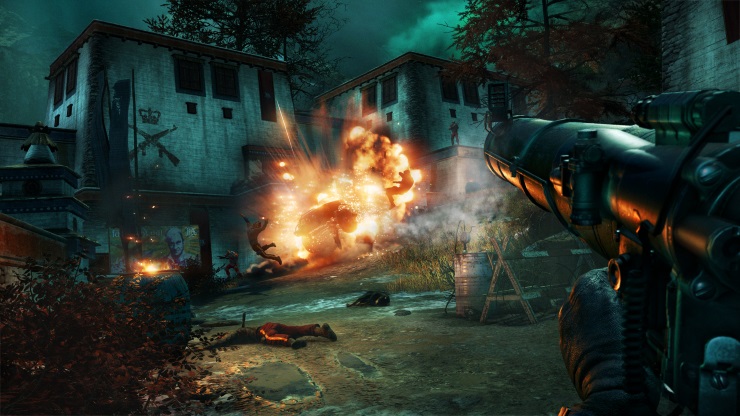
Elsewhere you can undertake a series of side-quests for Longinus and others, which are as well put together as the main campaign. The highlights by far are the Shangri-La missions, which transport you to the mythical realm, with a tiger to command and demons to fight.
A variety of activities flesh out the rest of the world: hostage rescues, escort missions and races, the usual fare. None are particularly challenging, and can actually be a little dull. Random Karma encounters are better, as you’re called to help defend an outpost, or chase down a courier (the latter led me to a particularly memorable gyrocopter vs. quad bike chase). That said, I had very little desire to return to the world after I’d finished it, though that doesn’t diminish the overall experience hugely.
Moments like that will stay in your mind, but little of the actual game world will. Kyrat looks stunning – we’re really beginning to see what next-gen can do – but it is all rocky, hilly forest. Even Far Cry 3 had more variety, but here one area largely looks like any other. It takes some of the fun out of exploration, and once the campaign’s finished – by which point you’ll most likely have taken the majority of outposts – there’s nothing major to keep you interested.
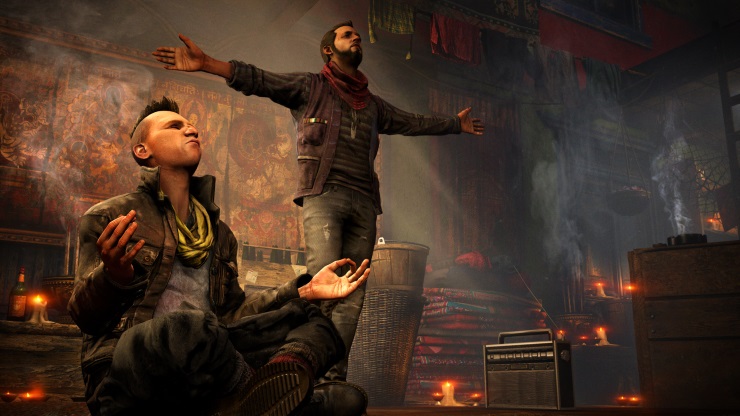
Underpinning all of this is solid – if a little generic – shooting. If you’ve played Far Cry 3 you’ll know what to expect: an entire arsenal of weapons ranging from uzi’s through machine guns to rocket launchers and flamethrowers. While you only start with one at a time, you can craft larger holsters as in the previous games to increase your capacity, up to a maximum of four. It is always best to take at least one silent weapon with you at all times, such as the bow and arrow, as you’ll never know when a mission will require stealth.
Staying hidden is another important gameplay element. It’s basic stuff: enemies have sight lines and will hear you if you’re too loud, but it works brilliantly. Even when you don’t need to be stealthy, it’s always useful to scope out a target before you attack, tagging soldiers and wildlife with your camera as in Far Cry 3. Don’t, and you risk being overwhelmed by guys you didn’t spot, as the AI are smart enough to flank you and use cover well.
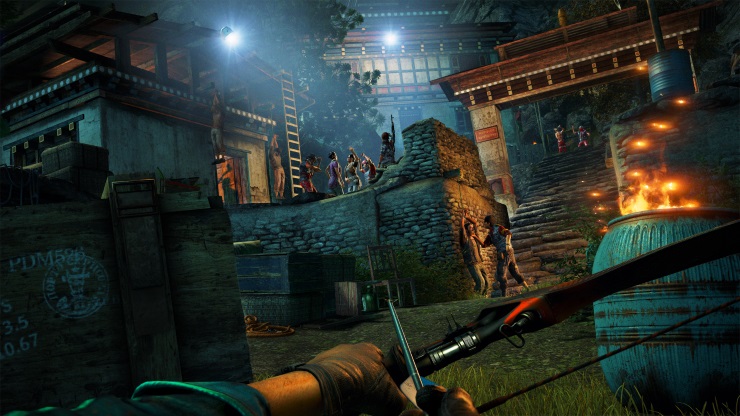
As well as standard grunts, there’re also enemies who’ll charge at you, heavy gunners and flamers. Most interesting are the hunters, bow-wielders who can control the local wildlife and don’t remain tagged for long. Because of the various enemies, each battle is unique, and you can choose a play style that suits you.
“The plot makes much
more sense than
last time around”
“The plot makes much
more sense than
last time around”
Two online modes complete the package. Co-op sets you loose in your single-player world or a friend’s. No missions are available, but all of the activities are still around, as are the outposts and fortresses. As in single-player the latter are fantastic fun, jointly scoping out and assaulting a target leading to some brilliant moments. That said, it becomes far too easy when there’re two of you, as you can almost guarantee to disable the alarm before reinforcements are called, and other than the outposts there isn’t really much to do.
Happily, PvP is much better. There are two sides: the conventionally armed Golden Path and the Rakshasa, who are armed with bows and arrows, turn invisible when crouched and can summon tigers and bears to fight for them (how cool is that?).

Amazingly, they’re quite well balanced. The three game modes consist of two attack and defend scenarios – one for each side – and a capture the flag variant called Demon Mask. Each match has two rounds, with teams swapping sides. The Rakshasa take a little while to get used to, while the Golden Path seem to have an edge right at the start of each round, having access to vehicles, but it evens out over the course of a match.
Overall the package might not be perfect, but Kyrat will find ways to keep you interested long after your first visit its mountainous vistas. The open world is just as good as, if not better in places than, its predecessor, but the story is where it really counts. Every character you meet has their own motivations, their own personality. There are twists and turns, some of which you’ll see a mile off, but some you won’t believe happened hours after the event. Insane moments are blended with genuine, heartfelt ones, and the juxtaposition doesn’t diminish either, but instead serves to emphasise them. Visit Kyrat and you won’t regret it.

